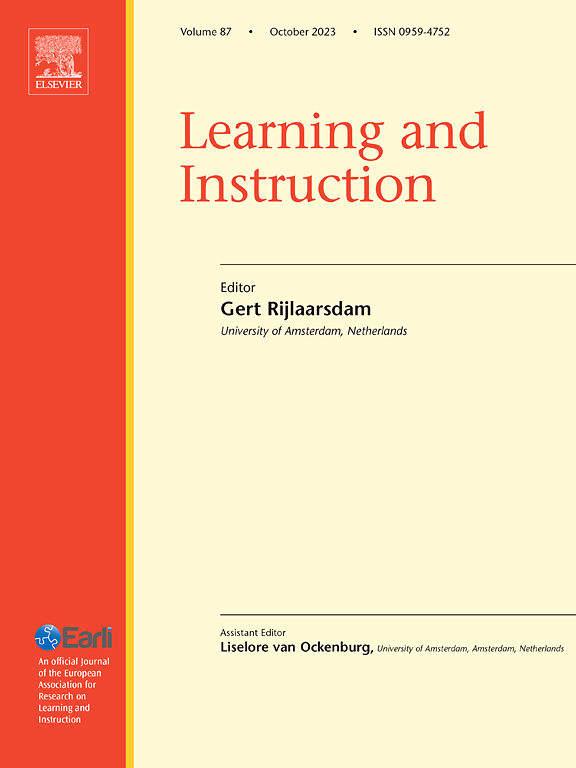本科护理教育中合作密室逃生活动的游戏体验、学习知觉和动机:一项混合方法研究
IF 4.9
1区 教育学
Q1 EDUCATION & EDUCATIONAL RESEARCH
引用次数: 0
摘要
背景景观教室是一种创新的教学方法,以解决问题为基础,注重学生的自主学习能力,以解决现实或虚拟的情况。用这种方法评估学生对自己的学习和动机的感知,以及对密室逃生的定性描述是有限的。目的评价参与密室逃生的学生在合作学习中的游戏体验、学习感知和动机。样本:所有选修“护理学历史、理论与方法II”课程的大二护理专业学生。方法采用序贯解释混合方法设计。通过游戏体验量表(GAMEX)和合作游戏学习策略(CMELAC)在密室逃生活动后收集定量数据。定性阶段涉及访谈的专题分析,以探索学生对活动的看法。结果GAMEX和CMELAC总分具有较高的趣味性(4.64±0.62分,满分6分)和激活性(4.34±0.87分,满分6分),二者具有显著的相关性(r = 0.566, p <;0.001)。定性主题强调了同志情谊、乐趣和学习的适用性作为积极方面,而有限的资源和消极的竞争力被指出是挑战。综合数据显示,高GAMEX分数与积极的定性体验相关。结论密室逃生活动是一种有效的教育手段,能提高患者的敬业度、团队精神和护理理念的应用。虽然资源限制和竞争因素构成挑战,但该活动支持有意义的学习和积极参与。这项研究强调了游戏化策略在护理教育中的潜力,建议进一步研究可扩展的适应性和对学习结果的可靠评估。本文章由计算机程序翻译,如有差异,请以英文原文为准。
Playful experience, learning perception, and motivation in a cooperative escape room activity in undergraduate nursing education: A mixed-methods study
Background
Escape rooms are an innovative pedagogical approach based on problem-solving and focused on the student's autonomous learning competencies to resolve a realistic or fictitious situation. Assessment of students' perception of their own learning and motivation with this approach, and the qualitative description of escape rooms is limited.
Aims
To evaluate the gameful experience, learning perception, and motivation in cooperative learning among students participating in an escape room.
Sample
All sophomore nursing students enrolled in the subject ‘History, Theory and Methods of Nursing II’.
Methods
A sequential explanatory mixed-methods design was employed. Quantitative data were collected through Gameful Experience Scale (GAMEX) and Cooperative Playful Learning Strategies (CMELAC) after the escape room activity. The qualitative phase involved thematic analysis of interviews to explore students' perceptions of the activity.
Results
Quantitative analysis revealed high enjoyment (4.64 ± 0.62 out of 6 points) and activation (4.34 ± 0.87 out of 6 points) scores, with significant correlations between GAMEX and CMELAC total scores (r = 0.566, p < 0.001). Qualitative themes highlighted camaraderie, fun, and applicability of learning as positive aspects, while limited resources and negative competitiveness were noted challenges. Integrated data showed that high GAMEX scores correlated with positive qualitative experiences.
Conclusions
The escape room activity was an effective educational tool, enhancing engagement, teamwork, and application of nursing concepts. While resource constraints and competitive elements posed challenges, the activity supported meaningful learning and active participation. This study underscores the potential of gamified strategies in nursing education, recommending further research on scalable adaptations and robust assessment of learning outcomes.
求助全文
通过发布文献求助,成功后即可免费获取论文全文。
去求助
来源期刊

Learning and Instruction
Multiple-
CiteScore
11.30
自引率
4.80%
发文量
109
期刊介绍:
As an international, multi-disciplinary, peer-refereed journal, Learning and Instruction provides a platform for the publication of the most advanced scientific research in the areas of learning, development, instruction and teaching. The journal welcomes original empirical investigations. The papers may represent a variety of theoretical perspectives and different methodological approaches. They may refer to any age level, from infants to adults and to a diversity of learning and instructional settings, from laboratory experiments to field studies. The major criteria in the review and the selection process concern the significance of the contribution to the area of learning and instruction, and the rigor of the study.
 求助内容:
求助内容: 应助结果提醒方式:
应助结果提醒方式:


